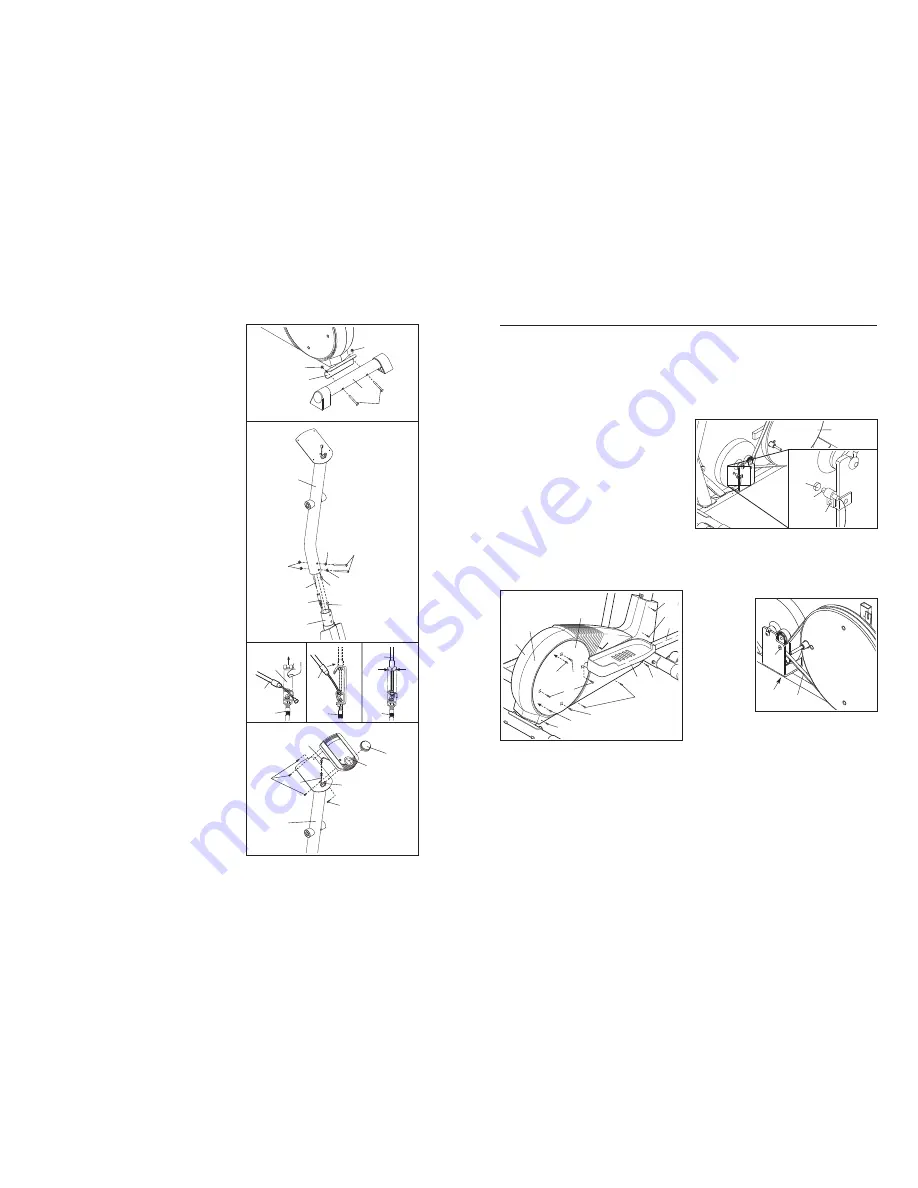
Inspect and properly tighten all parts of the elliptical
trainer regularly. Replace any worn parts immediately.
The elliptical trainer can be cleaned with a soft cloth
and a small amount of mild detergent.
Do not use
abrasives or solvents.
To prevent damage to the
console, keep liquids away from the console and keep
the console out of direct sunlight.
When storing the elliptical trainer, remove the batter-
ies from the console. Keep the elliptical trainer in a
clean, dry location, away from moisture and dust.
CONSOLE TROUBLESHOOTING
If the console does not function properly, replace the
batteries (see assembly step 9 on page 8).
HOW TO ADJUST THE REED SWITCH
If the console does not display correct feedback, the
reed switch should be adjusted. To adjust the reed
switch, first see assembly step 8 on page 8 and
remove the Pedals (13, 14). Next, see step 7 on page
7 and remove the Pedal Arms (11, 12).
Next, remove all of the Screws (51, 70) from the right
Pedal Disc (15), and slide the Pedal Disc off. Remove
all Screws (52, 64, 69) from the Right Side Shield (4),
and remove the Right Side Shield. Remove all
Screws (52) from the Left Side Shield (3), and remove
the Left Side Shield.
Next, see the drawing below and locate the Reed
Switch (53). Loosen, but do not remove, the indicated
Screw (52). Slide the Reed Switch slightly toward or
away from the Magnet (58) on the flywheel. Retighten
the Screw. Turn the left Pedal Disc (15) for a moment.
Repeat until the console displays correct feedback.
When the Reed Switch (53) is correctly adjusted, reat-
tach the Side Shields (3, 4), the right Pedal Disc (15),
the Pedal Arms (11, 12), and the Pedals (13, 14).
HOW TO ADJUST THE DRIVE BELT
If you can feel
the pedals slip
whilst you are
pedaling,
even when
the resistance
knob is turned
to the maxi-
mum setting,
the Drive Belt
(19) may
need to be
adjusted. To
adjust the
Drive Belt, you must remove both side shields. See
the instructions at the left and remove the side
shields.
Next, loosen the M8 x 22mm Flat Head Bolt (68) and
turn the M10 x 60mm Button Screw (62) until the
Drive Belt (19) is tight. Once the Drive Belt is tight,
tighten the Flat Head Bolt. Reattach the side shields.
6
11
2. Whilst another person lifts the back of the Frame (1)
slightly, attach the Rear Stabiliser (9) to the Frame
with two M10 x 75mm Carriage Bolts (34) and two
M10 Nylon Locknuts (33).
33
1
2
34
9
33
MAINTENANCE AND TROUBLESHOOTING
64
69
51
70
70
69
52
52
64
64
14
12
4
58
53
52
15
15
3
68
62
19
3. Whilst another person holds the Upright (2) near the
Frame (1) as shown, connect the Upper Wire (44) to
the Reed Switch Wire (53).
Next, connect the Resistance Cable (45) to the
Lower Resistance Cable (65) in the following way:
• See drawing A. Pull up on the metal bracket, and
insert the tip of the Resistance Cable (45) into the
wire clip on the Lower Resistance Cable (65) as
shown.
• See drawing B.
Firmly
pull the Resistance Cable
(45) and slide it into the metal bracket on the
Lower Resistance Cable (65) as shown.
• See drawing C. Using pliers, squeeze the prongs
on the upper end of the metal bracket together.
Slide the Upright (2) onto the Frame (1);
make sure
not to pinch the wires or cables
. Attach the Upright
with two M10 x 76mm Button Bolts (67), two M10
Nylon Locknuts (33), and two M10 Split Washers (59).
Do not tighten the Button Bolts yet.
65
65
45
Metal
Bracket
45
B
A
C
65
45
4
42
44
45
Console
Wire
42
63
23
2
4. Connect the Upper Wire (44) to the wire on the
Console (23). Next, attach the Console to the Upright
(2) with four M4 x 12mm Screws (42).
Press the Resistance Knob (63) onto the Resistance
Control (45).
64
65
44
45
67
33
59
59
53
2
1
Make sure not to
pinch the wires
or cables
.
3

























